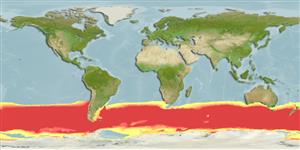Common names from other countries
>
Scombriformes (Mackerels) >
Gempylidae (Snake mackerels)
Etymology: Paradiplospinus: Greek, para = the side of + Greek, diploos = double + Latin, spina, pinna = thron (Ref. 45335).
More on author: Andriashev.
Issue
Validity of species questionnable for some authors, but no recent publications.
Environment: milieu / climate zone / depth range / distribution range
Ecologia
marinhas batipelágico; intervalo de profundidade 0 - 2830 m (Ref. 6181). Deep-water; 31°S - 79°S, 180°W - 180°E (Ref. 6181)
Southern Ocean: circumpolar. In the belief that there was only a single species of Paradiplospinus, many authors used the name Paradiplospinus gracilis as including Paradiplospinus antarcticus.
Tamanho / Peso / Idade
Maturity: Lm ? range ? - ? cm
Max length : 52.0 cm SL macho/indeterminado; (Ref. 6181); common length : 35.0 cm SL macho/indeterminado; (Ref. 6181)
Espinhos dorsais (total): 36 - 39; Raios dorsais moles (total): 24-34; Espinhos anais 2; Raios anais moles: 25 - 31; Vértebras: 64 - 67. Body is extremely elongate. Mouth with fang-like teeth, 3-6 fangs anteriorly in upper jaw and 1 fang on each side of the lower jaw. Pyloric caeca 6. Color is silvery white without any conspicuous marks except 40 - 50 narrow longitudinal lines of pale melanophores; the dorsal-fin base, opercular region and caudal-fin origin dark brownish.
Adults and subadults epipelagic to mesopelagic, or mesobenthopelagic at shelves and slopes from surface to 830 m (temp. 0° to 4°C). Larvae and juveniles, probably mesopelagic to bathypelagic, down to 2,830 m depth (Ref. 5084). Feeds on krill, squid and fishes (predominantly myctophids). Larval and juvenile specimens mostly obtained between southern land masses and the Antarctic continent.
Life cycle and mating behavior
Maturidade | Reprodução | Desova | Ovos | Fecundidade | Larvas
Nakamura, I. and N.V. Parin, 1993. FAO Species Catalogue. Vol. 15. Snake mackerels and cutlassfishes of the world (families Gempylidae and Trichiuridae). An annotated and illustrated catalogue of the snake mackerels, snoeks, escolars, gemfishes, sackfishes, domine, oilfish, cutlassfishes,. scabbardfishes, hairtails, and frostfishes known to date. FAO Fish. Synop. 125(15):136 p. (Ref. 6181)
Categoria na Lista Vermelha da IUCN (Ref. 130435)
CITES (Ref. 128078)
Not Evaluated
Ameaça para o homem
Harmless
Utilização humana
Pescarias: sem interesse
Mais informação
Nomes comunsSinónimosMetabolismoPredadoresEcotoxicologiaReproduçãoMaturidadeDesovaFecundidadeOvosDesenvolvimento dos ovos
ReferênciasAquaculturaPerfil para aquaculturaEstirpesGenéticaElectrophoresesHereditariedadeDoençasProcessamentoMass conversion
ColaboradoresFotografiasStamps, Coins Misc.SonsCiguateraVelocidadeTipo de nataçãoÁrea branquialOutras referênciasCérebrosVisão
Ferramentas
Relatórios especiais
Descarregue XML
Fontes da internet
Estimates based on models
Preferred temperature (Ref.
115969): 0.8 - 7.8, mean 3.5 (based on 694 cells).
Phylogenetic diversity index (Ref.
82804): PD
50 = 0.7500 [Uniqueness, from 0.5 = low to 2.0 = high].
Bayesian length-weight: a=0.00363 (0.00163 - 0.00807), b=3.10 (2.91 - 3.29), in cm Total Length, based on LWR estimates for this (Sub)family-body shape (Ref.
93245).
Nível Trófico (Ref.
69278): 4.1 ±0.53 se; based on food items.
Resiliência (Ref.
120179): Médio, tempo mínimo de duplicação da população 1,4 - 4,4 anos (Preliminary K or Fecundity.).
Fishing Vulnerability (Ref.
59153): Moderate to high vulnerability (45 of 100).
